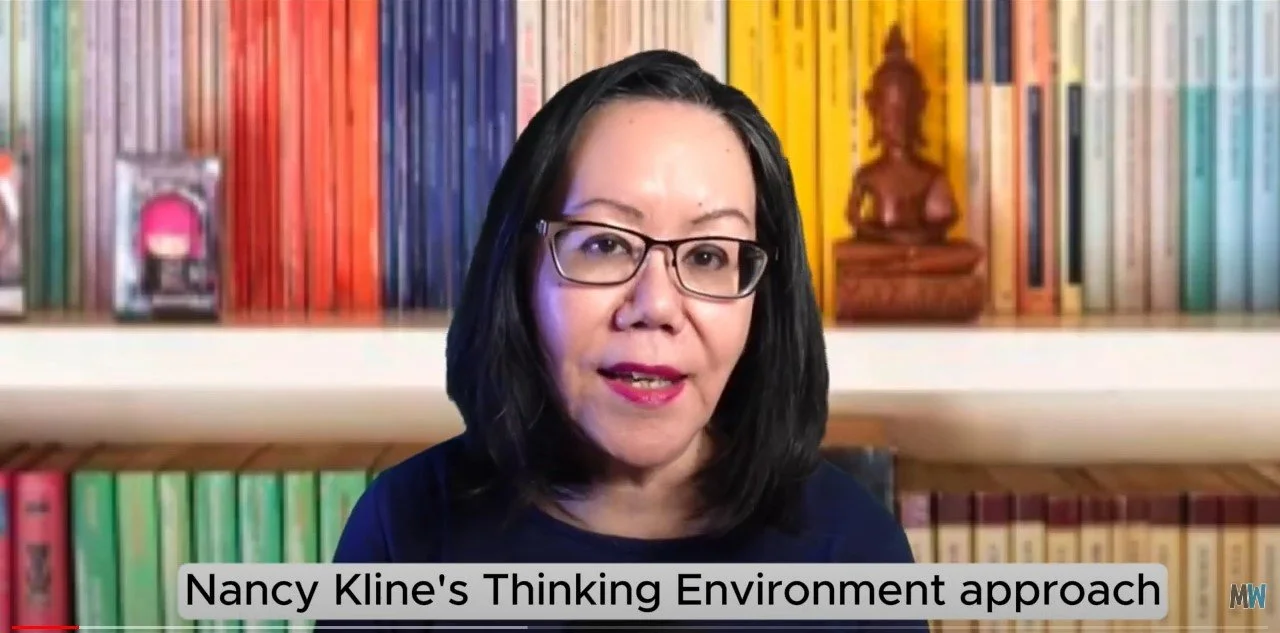
The Thinking Environment
The quality of everything we do depends on the quality of the thinking we do first. The quality of our thinking depends on the way we treat each other while we are thinking.
Nancy Kline
The Thinking Environment - moving meetings from timewasting to trailblazing
An approach that transforms organisations
The Thinking Environment is a set of conditions that help people to think well for themselves. It was developed by Nancy Kline, President Time to Think, and is the product of her observation that in order for people to think clearly and independently, the people around them need to behave in certain ways.
Nancy’s Thinking Environment approach underpins all of my work and I am proud to be a member of her Time to Think Collegiate.
I have had the privilege of taking this transformational approach into multi-national corporations such as Skanska, Sony Pictures and Arup as well into the NHS, Judicial Office and Cabinet Office.
"This was a fulfilling and ‘ work-changing’ session. Attendees ranged from chairmen of global organisations to senior regulators and those running smaller agencies. By educating us in how to create a ‘thinking environment’, which is not only inclusive but promotes fresh and clear thoughts, the meetings become more productive and engaging. Applying this in practice was a joy with immediate results."
Richard Karmel, Managing Partner - Mazars, London
Core Trainings
-

The Thinking Environment™ Foundation Course
Learn to transform everyday work and business communications into clear-thinking, invigorating, positive experiences.
-

The Thinking Partnership™
Liberate your own independent thinking, undergo shifts as a thinker, have epiphanies, and create a deeply held space for others to do the same
-

Transforming Meetings™
Perfect for organisations and leaders who want to use the Thinking Environment to run better meetings and produce the finest thinking from everyone.
Within 1 year, you could be a Time to Think Facilitator or Coach
Are you an experienced coach or facilitator seeking to enhance your impact, or perhaps just beginning your journey? The Time to Think qualification pathway offers a structured yet flexible path toward accreditation. Recognised for its pioneering approach, the Thinking Environment stands at the forefront of coach and facilitator training.
The Ten Components of a Thinking Environment
Time To Think has identified ten behaviours that generate the finest independent thinking. These are called Ten Components of a Thinking Environment
In the presence of this ‘way of being’ people think for themselves with rigour, imagination, courage and grace.
Each component that forms an effective Thinking Environment is powerful just on its own. Combine them together and the process delivers transformative impact for both organisations, teams, and individuals.
The ten components are:
Attention, Equality, Ease, Appreciation, Encouragement, Feelings, Information, Difference, Incisive Questions, and Place.
-
ATTENTION: Listening without interruption and with interest in where the person will go next in their thinking
EQUALITY: Regarding each other as thinking peers, giving equal time to think
EASE: Discarding internal urgency
APPRECIATION: Noticing what is good and saying it
FEELINGS: Welcoming the release of emotion
ENCOURAGEMENT: Giving courage to go to the unexplored edge of our thinking by ceasing competition as thinkers
INFORMATION: Absorbing all the relevant facts
DIFFERENCE: Prioritising diversity of group identities and understanding their lived experience
INCISIVE QUESTIONS: Freeing the human mind of an untrue assumption lived as true
PLACE: Producing a physical environment — the room, the listener, your body — that says, ‘You matter’
Bespoke programmes and coaching - Examples:
“I think we often feel as though our voice isn’t heard and people don’t value our ideas. Mitzi taught us about Nancy Kline’s Time to Think approach and helped us to work out how we could create the right environment for everyone to feel confident, prepared and supported to think & speak up."
Janet Thornley RN MSc ACP, GPN Strategic Lead BLMK Integrated Care System
Simple Execution, Profound Results
I help individuals to apply the ten components so they can create Thinking Environments for themselves and their organisations.
The result is simple but profound. Everyone at every level can think for themselves.
For example:
The Havers’ Masters study found a 95% consistency in the outcomes of meetings held in a Thinking Environment, including that these meetings time and again:
Produced a measurable, positive impact on performance indicators of organisations
Generated better ideas, solutions, and decisions
Created an environment in which people felt valued and equal
Achieved resolution faster
Gave rise to greater participation and involvement from everyone
Fostered productive working relationships
You can achieve these results too.
Book a free 30-minute discovery call to learn more about Thinking Environments and how you can learn to apply the ten components.





